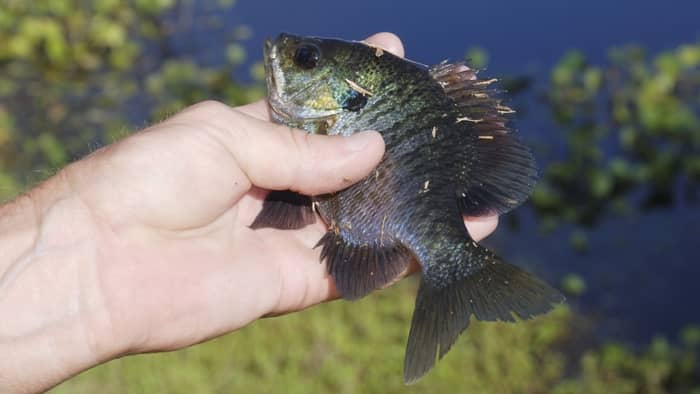Last Updated on November 6, 2021 by Marco C.
Fish selection is one of the most exciting parts of aquaponics. If you are considering raising crappie you have come to the perfect place to learn all about how fast crappie grow, what crappie eat, and how to create the ideal conditions for their survival.
Crappies, also known as speckled bass, are part of the Sunfish family. They originated from the waters on the East Coast of the U.S.A. Nowadays, they can be raised in many more places. There are two main kinds of Crappie- the black crappie and the white crappie.
They can be told apart based on the amount of spines on their dorsal. Black Crappies have 6-7 spines while the white crappies have 5-6.
They also have different patterns on their bodies. White crappies have patterned stripes running vertically on their body. Black Crappies have irregular dark spots throughout their skin.
Since both kinds require similar living conditions, it doesn’t matter which ones you decide to raise. There will be some minor differences though.
Black crappies like to have clean and calm waters but whites can tolerate cloudier conditions. Both are freshwater species.
White Crappies can happily swim in open waters, but black crappies like to hide out in plants. In nature, they can be found living among other freshwater species like bluegill or largemouth bass.
So depending on which kind of conditions you want to create- you can take your pick.
What Do Crappies Eat
Both types of crappie eat insects when they are young and begin to eat other small fish as they age. According to the United States Department of Agriculture crappies most commonly eat things like crayfish and minnows.
Black crappies tend to continue to eat more insects than fish once they are adults. Whereas white crappies eat more fish.
If fed correctly, the average size of a crappie is 9 inches long and ranges between 0.3-0.5 pounds. In a manmade aquarium, you will need to purchase insects or small fish from the pet store.
Every 12 hours you can drop four minnows or another small fish per crappie in your tank. So if you have 4 crappie you want to use 16 minnows.
You can test different types of food to see which ones your crappies like best. Try different things like insect larvae, small yellow perch, or goldfish. Feeding them fresh fish will be the best thing to keep them growing strong.
They may not take well to store-bought fish food pellets so pay attention to understand the habits of your specific fish.
Small Crappie
Crappie will spawn during the spring in North America. Similar to many fish, the male crappies will clear a space at the bottom of the water to allow for the females to lay their eggs. Females are known to lay eggs in more than one males nest.
Once they reach 6 inches they are able to make babies. Eggs can hatch within 5 days. The males usually hang around the nest until the eggs hatch to protect them from being eaten.
However, it is not guaranteed that these fish will spawn every year. It is common to see variations in spawning ranging from light spawning to none the back to heavy depending on the year.
Small fingerlings (around 3-4 inches) will grow between 7 to 9 inches over the year.
Crappie Growth Rates
In comparison, white crappies tend to grow faster than black ones. On average they live to be around 4 years old but can reach up to 10 years maximum.
Learn more about: The Incredible Facts On How Fast Trout Grows!
When they are adults they can reach 9 inches in length but if kept in perfect conditions, they can possibly reach up to 15 inches. You have an advantage raising crappies in a closed system because you can control the food supply and environment.
The growth rate is heavily impacted by the amount of fish in your tank and food supply. Usually, crappies can grow 8-10 inches over a two-year period.
They gain weight faster after reaching the length of 8.8 inches. This is an incentive for fish farmers because the higher the weight the more the price. If you want your crappies to grow fast, make sure you do not overstock your tank.
The ideal density is about 2-3 crappie per 80 gallons of water. So a 150-gallon tank could hold 6 crappies.
If your crappie is under 6 inches after two years, it is a problem. A very important thing to note is that the diet changes significantly for crappies once it reaches a certain size.
So if your fish are under 6 inches make sure to keep to a diet that is mostly zooplankton. They may not be able to process typical adult food at this size.
Setting Up Your Tank For Crappie
As usual, your best bet for success is to most closely mimic the crappie’s natural environment. They like to live under rocks and vegetation in a dark place.
Be sure to not keep your tank too bright. You could even use darker colored rocks to change the coloration of the water.
Crappies love to hide so make sure to provide plenty of spaces for that. Crappies can survive in a wide range of temperatures.
If you don’t want to worry about temperature controlling your tank this could be a great choice. Keep the PH at the ideal range of 6.6- 7.8 and the tank clean.
The best part about raising crappies is their delicious taste that they are well known for. They even have a nickname of “Panfish” because they fit perfectly in a frying pan. So whether the fish are for sale or for personal use, you are sure to be satisfied.
It is also nice that you can raise these fish amongst other species, which allows your aquaponics system to have some nice diversity. Pay attention to how the fish respond to different conditions and fine-tune it based on your observations.
After reading this article, you should have a good understanding on how fast crappie grow. They are great fast-growing addition to your aquaponics system.
Remember, every situation is unique so taking close care will ensure success in your endeavor.
Feel free to comment and ask questions below.

Candace is an aquaponics expert with over 5 years of experience in the field. She has a degree in environmental science from the University of California, Berkeley and a degree in aquaponics from the University of Florida. She is passionate about sustainable agriculture and has a deep knowledge of aquaculture and hydroponics. She has worked on numerous projects and has been involved in the development of aquaponic systems and fish farms. She also has experience in designing and constructing aquaponic systems. With her expertise, Candace is able to advise clients on the most effective and efficient way to construct and manage their aquaponic system. She is an active member of the aquaponic community, often speaking at conferences and seminars. Candace is dedicated to helping others understand the importance of aquaponics, and she is a strong advocate for sustainable food production.


Leave a Reply
You must be logged in to post a comment.